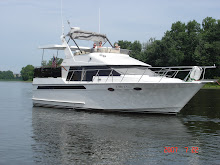
Cruising the beautiful Pasquotank River this morning

Dismal Swamp Canal at about MM 31

Tom, with Dismal Swamp Canal in background

Diann

Noah Genda at free Visitors Center Dock

Noah Genda at Dismal Swamp Canal visitors center
We didn’t mention our cruise across the Abermarle Sound on Wednesday. We had to weave our way through so many (1,000's) crab pots, I’m ready to give up eating crab! In addition, we encountered 3-4 foot quartering waves which makes the trip a little unpleasant and plus it gets hard to distinguish between the white caps and the crab pots. Tom did a great job of avoiding them.
At this point of the journey it was necessary to make a route choice. Select either the faster “Virginia Cut” route or the slower but more scenic “Great Dismal Swamp”. We chose the Dismal Swamp route which offers a spectacular scenic route leaving Elizabeth City, up the Pasquotank River and into the Turner Cut bringing you to the “South Mills” lock of the Dismal Swamp. What a beautiful winding cruise through some of the most remote areas we have experienced since the Tombigbee Waterway. It is so quiet, with pristine clean water, but tannic and very little development. Once in a while you would come across a dwelling in the wilderness that is miles from civilization as we know it. At MM 28 there is a State Visitors Center and museum with a free dock for overnight transient boaters where we have decided to spend the night. There are four other boats tied to the wall with us.
In 1793, construction began on the Dismal Swamp Canal. The canal had to be dug completely by hand so progress was slow and expensive. Most of the labor was done by slaves hired from nearby landowners. It is interesting to note that the slaves became so familiar with the swamp during this period that it eventually became a haven for runaways.
The Dismal Swamp Canal is the oldest operating artificial waterway in the United States. Visitors and canal navigators travel where famous explorers and presidents have stood and literary greats have been inspired for over two hundred years. For example, astride the two states' border is the site where the infamous "Halfway House" hotel was built in the late 1820's. The hotel was a popular spot for marriages, duels and those escaping the law. Since the hotel was on the state line, this last group simply walked to the other side of the hotel to avoid being captured in either state. It is also said that Edgar Allen Poe wrote "The Raven" during one of his stays at the hotel.
Today, the Dismal Swamp Canal is on the National Register of Historic Places as a Historic Landmark, and is also noted as a National Historic Civil Engineering Landmark. In February 2004, the Dismal Swamp Canal was included in the National Park Service's Underground Railroad Network to Freedom Program. It is maintained by The U.S. Army Corps of Engineers as a navigational resource along the Atlantic Intracoastal Waterway
The “Dismal Swamp” name dates back to 1669 and there is debatable discussion on the origin of this less than flattering name. This subject is extremely interesting American history and too long for this blog, but for an interesting read. Use your favorite search engine for “Dismal Swamp history” or “Dismal Swamp Canal” you will find it fascinating.

No comments:
Post a Comment